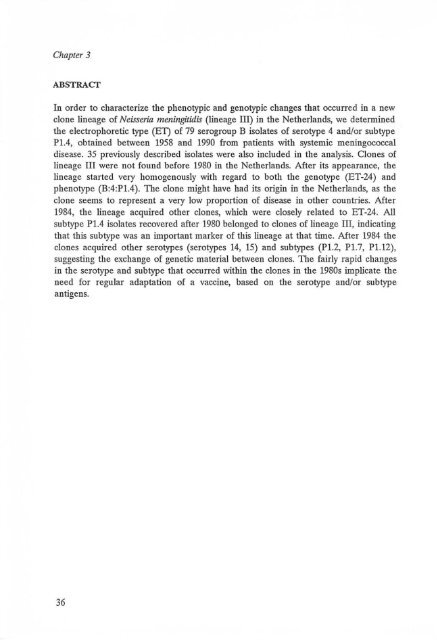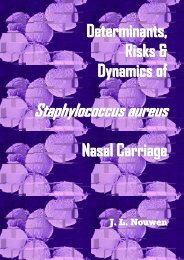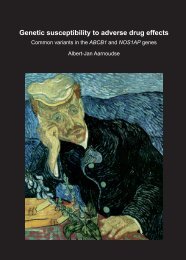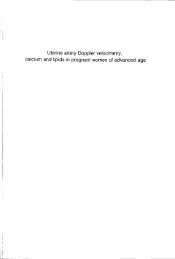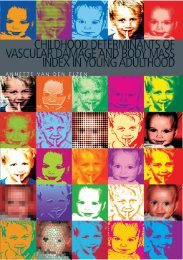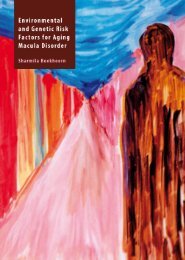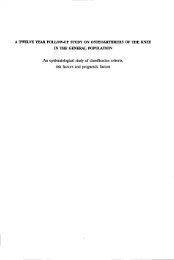Chapter 3ABSTRACTIn order to characterize the phenotypic <strong>an</strong>d genotypic cb<strong>an</strong>ges th<strong>at</strong> occurred in a newclone lineage of Neisseria meningitidis (lineage 1Il) in tbe Netherl<strong>an</strong>ds, we determinedthe electropboretic type (ET) of 79 serogroup B isol<strong>at</strong>es of serotype 4 <strong>an</strong>d/or subtypePI.4, obtained between 1958 <strong>an</strong>d 1990 from p<strong>at</strong>ients with systemic meningococcaldisease. 35 previously described isol<strong>at</strong>es were also included in the <strong>an</strong>alysis. Clones oflineage III were not found before 1980 in the Netherl<strong>an</strong>ds. After its appear<strong>an</strong>ce, thelineage started very bomogenously with regard to both the genotype (ET-24) <strong>an</strong>dphenotype (B:4:PI.4). The clone might have had its origin in tbe Netherl<strong>an</strong>ds, as theclone seems to represent a very low proportion of disease in other countries. After1984, the lineage acquired other clones, whicb were closely rel<strong>at</strong>ed to ET-24. Allsubtype Pl.4 isol<strong>at</strong>es recovered after 1980 belonged to clones of lineage Ill, indic<strong>at</strong>ingth<strong>at</strong> this subtype was <strong>an</strong> import<strong>an</strong>t marker of tbis lineage <strong>at</strong> th<strong>at</strong> time. After 1984 tbeclones acquired other serotypes (serotypes 14, 15) <strong>an</strong>d subtypes (P1.2, Pl.7, P1.12),suggesting the exch<strong>an</strong>ge of genetic m<strong>at</strong>erial between clones. TIle fairly rapid ch<strong>an</strong>gesin the serotype <strong>an</strong>d subtype th<strong>at</strong> occurred within the clones in the 1980s implic<strong>at</strong>e theneed for regular adapt<strong>at</strong>ion of a vaccine, based on the serotype <strong>an</strong>d/or subtype<strong>an</strong>tigens.36
Evolution of meningococcal cionesINTRODUCTIONMeningococci are classified into serogroups, serotypes <strong>an</strong>d subtypes on the basis of<strong>an</strong>tigenic differences in tbeir capsular polysaccharides, class 2/3 Quter membr<strong>an</strong>eproteins (aMPs) <strong>an</strong>d class 1 aMPs, respectively.' Studying the distribution of thesesurface structures bas proved to be useful for <strong>an</strong>alysing the spread of meningococcaldisease (MD).2-S In recent years it has been shown th<strong>at</strong> meningococci have a clonalpopul<strong>at</strong>ion structure, <strong>an</strong>d the characteriz<strong>at</strong>ion of the chromosomal genotype ofNeisseria meningilidis by multilocus enzyme electrophoresis has shown to be <strong>an</strong> evenmore powerful tool for studying the epidemiology of MD.... If closely rel<strong>at</strong>edmeningococcal clones are homogenous with regard to the phenotype, the results ofthe surface characteriz<strong>at</strong>ion of N. menillgitidis <strong>an</strong>d genotyping will be similar, <strong>an</strong>d willlead to the same inferences. This was the case with strain B:2b:P1.2 which caused the1966 epidemic <strong>an</strong>d a hyperendemic wave in 1972 in the Netherl<strong>an</strong>ds.' 4 All B:2b:P1.2isol<strong>at</strong>es, of which the electrophoretic type (ET) was determined, belonged to acomplex of closely rel<strong>at</strong>ed clones (lineage I1) <strong>an</strong>d this complex contained o<strong>nl</strong>y a fewother phenotypes." However, multilocus enzyme electrophoresis revealed th<strong>at</strong> theclone th<strong>at</strong> caused the hyperendemic wave of 1972 differed from the clone th<strong>at</strong>domin<strong>at</strong>ed the 1966 epidemic, <strong>an</strong>d offered, therefore, a further refinement' If,however, a lineage of closely rel<strong>at</strong>ed clones is heterogenous with regard to thephenotype, results obtained by typing methods based on surface <strong>an</strong>tigens may notlead to comparable inferences. <strong>An</strong> example of this situ<strong>at</strong>ion is the ET-5 complex.Clones of the ET-5 complex caused several outbreaks of MD all over the world, afterbaving caused the Nonvegi<strong>an</strong> epidemic, but m<strong>an</strong>y phenotypes were found amongisol<strong>at</strong>es of this complex, <strong>an</strong>d epidemics in different countries were often caused bystrains with distinct phenotypes (e.g. B:15:P1.7,16, B:4:P1.l5 <strong>an</strong>d B:15:P1.3).' 7Since 1958, meningococcal isol<strong>at</strong>es from blood <strong>an</strong>d/or cerebrospinal fluid (CSF) ofp<strong>at</strong>ients with systemic MD have been submitted for further classific<strong>at</strong>ion to theReference Labor<strong>at</strong>ory for Bacterial Meningitis (RLBM) in Amsterdam by almost allclinical microbiological labor<strong>at</strong>ories in the Netherl<strong>an</strong>ds. Research on this extensivecollection of strains, which currently comprises of approxim<strong>at</strong>ely 7000 meningococcalisol<strong>at</strong>es, has demonstr<strong>at</strong>ed th<strong>at</strong> a new lineage of 2 closely rel<strong>at</strong>ed clones of N.meningitidis (lineage Ill) appeared in the Netherl<strong>an</strong>ds around 1980.' This lineage waspartly responsible for the increase in the incidence of MD in the Netherl<strong>an</strong>ds after1982; it was estim<strong>at</strong>ed th<strong>at</strong> approxim<strong>at</strong>ely 40% of the cases of serogroup B MD in theNetherl<strong>an</strong>ds in 1987 were due to clones of this lineage.' It has subsequently beendemonstr<strong>at</strong>ed th<strong>at</strong> this lineage consisted almost exclusively of a new meningococcalphenotype (B:4:P1.4) which was encountered for the first time ill the Netherl<strong>an</strong>dsaround 1980 <strong>an</strong>d became the most prevalent phenotype in 1990 (21% of all isol<strong>at</strong>es)'When observing the ch<strong>an</strong>ging distribution of serotypes <strong>an</strong>d subtypes among serogroupB meningococci in the Netherl<strong>an</strong>ds from 1958 to 1990, the subtype Pl.4 of the newphenotype deserves special <strong>at</strong>tention. Before 1980 this subtype was rarely encoun-37


